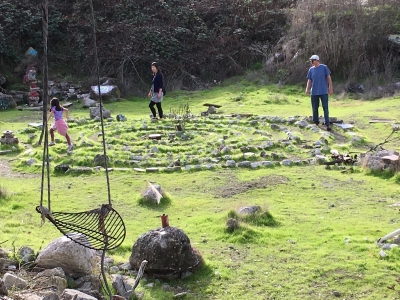
What is the value of an urban wild? What social, ecological, and cultural functions does a weedy vacant lot, a wetland fragment, or an abandoned rail corridor serve? Global Urban Humanities Project Director Susan Moffat will give a talk on urban wilds at the annual conference of the American Society of Landscape Architects in San Diego.
Urban Wild! Making the Case for Our Unclaimed Landscapes
Friday, November 15 at 1:30 pm at the ASLA Annual Conference in San Diego.
For the past six years Moffat has been studying one particular urban wild--the former construction debris landfill known as the Albany Bulb, a peninsula of rubble, wildflowers and salt marsh that juts a mile into San Francisco Bay.
This rugged, largely undeveloped park raises complicated questions about the design and management of abandoned infrastructure sites. Once home to a long-term community of unhoused people, as well as serving as a popular spot for guerilla art and dog walking, the landfill is in the process of conversion to a state park. Following the elimination of the encampments in 2014, some parts of the land have been brought under conventional park management, while other parts have been left in a state of informal self-management. Park users continue to make scrap metal and driftwood art, outdoor furniture, and trails that are used by dog walkers, birdwatchers, and people who come to see the sculptures or to build shrines that express their sense of sacred space. Salt marshes, mudflats, and a diverse collection of trees and wildflowers have emerged without official plans or management.
Moffat believes that art, especially participatory art, has the power to unlock secrets of landscape function and potential that may not be captured through traditional methods of analysis and design. She has worked with artists, community members, and designers to bring theater and dance performances to the site in works that illuminate both the damage that humans have done to the local ecosystem, and to examine the ways that nature has pushed back. Through sculptural installations and social practice art, Moffat and her collaborators have sought to uncover the layers of both social and natural history of the site rather than erase it. In 2019, she curated the Bulbfest: Resilience dance and art festival, which built on an earlier 2018 festival to bring together 11 dance groups including Oakland's Destiny Arts and the Sarah Bush Dance Project and 15 art installations.
The Albany Bulb has long served as a laboratory for landscape architecture faculty and students from around the Bay Area, including in many UC Berkeley College of Environmental Design courses. That activity has picked up in recent years, with scores of UC Berkeley students collaborating on projects at the Bulb. Students of Professor of Architecture Rene Davids created outdoor seating, a stage, and other amenities. And students in a course cross-listed in Theater and Landscape Architecture created a site specific performance under the guidance of choreographer Erika Chong Shuch, urban designer Ghigo DiTommaso, and Moffat, who is an urban planner.
For Bulbfest 2019, Robert Ungar, a recent UC Berkeley Master of Urban Design graduate, served as art manager and Professor of Theater, Dance and Performance Studies Lisa Wymore served on the dance jury. Landscape Architecture and Environmental Design graduates Peter Trio and Cristina Bejarano were selected to create a landscape and language installation, while other UC Berkeley students helped visitors navigate the complicated topography of the site.
At the ASLA conference, Moffat will join Harvard Graduate School of Design Associate Professor Jill Desimini and panel organizer John Gibbs of landscape architecture firm WRT to explore definitions of "wild," "natural," "park," "restoration" and "conservation" to spark a conversation about how park plans might codify and protect the unique value of unclaimed spaces.
